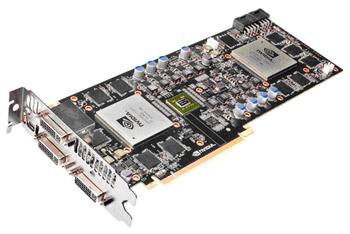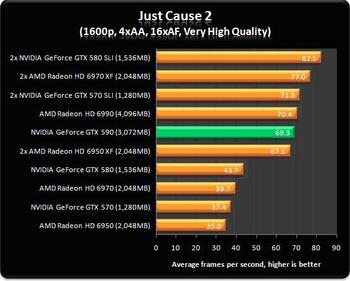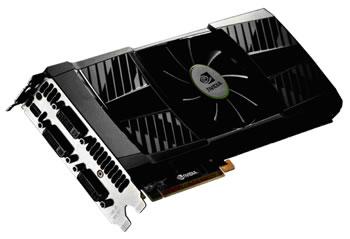The battle for performance supremacy
NVIDIA and AMD know only too well that the path to performance domination in the consumer PC graphics market can only be trod if two high-end GPUs are placed onto one board and set to communicate with one another via established multi-GPU technology.
The main obstacle in creating these two-GPU behemoths isn't technical, for the architecture has already been defined and delivered in single-GPU cards. At present, these GPUs are the GeForce GTX 570/580 and Radeon HD 6950/6970 for NVIDIA and AMD, respectively.
Instead, the problem facing designers is how best to reconcile the competing interests of performance and overall power-draw. You see, any marketable card needs to temper power-draw to below 450W, and the reason for this lies with pragmatism over enthusiast zeal. 12V power delivery from most PSUs, PCIe power-draw, chassis design and top-line air-cooling align to force GPUs to keep under this somewhat arbitrary figure. One could always steal a few watts here or there, but having a fairly quiet card puts a lid on just how much juice it call pull.
Power play
NVIDIA's fastest single graphics card, the GeForce GTX 580 - clocked in at 772MHz core and 4,008MHz memory - pulls an average of 244W when running at full tilt. Putting two such GPUs on one board will push the boundaries of what's possible, even if the GPUs are screened to run at those speeds at lower-than-normal voltage settings.
In order to get around such obstacles, the company's dual-GPU solution - the GeForce GTX 590 - uses two GTX 580 cores with a twist. Architecturally, both of the GTX 590's GPUs are exactly the same as GTX 580 - they each have 512 cores, 64 texture-units, 48 ROPs and a 384-bit memory interface to 1,536MB of GDDR5 RAM, per GPU.
However, in order to keep power-draw within reason, NVIDIA tones down each GPU by reducing speeds to 607MHz core and 3,414MHz memory, representing a 21.4 and 14.8 per cent reduction in the two headline figures. The two GPUs are connected together via a PCIe 2.0 x16 interface and combined via NVIDIA's SLI technology - resulting in the birth of the first dual-GPU Fermi graphics card.
What can you expect?
Benchmarks have shown that the single-GPU GeForce GTX 580 is comfortably faster than its immediate rival, AMD's Radeon HD 6970. But when AMD combined two of the aforementioned GPUs on a single PCB, it created the fastest graphics card in the world - Radeon HD 6990.
In theory, putting two full-fat GTX 580s on a single PCB - a.k.a. GTX 590 - should deliver the oomph required to topple AMD's high-end monstrosity. But it isn't quite that simple. By dialling down the speed of the GTX 590 GPUs, NVIDIA's enthusiast effort is hard pushed to knock HD 6990 from its perch.
| GPU | NVIDIA GeForce GTX 590 3,072MB | NVIDIA GeForce GTX 580 1,536MB | NVIDIA GeForce GTX570 1,280MB | Radeon HD6990 4,096MB | Radeon HD6970 2,048MB | Radeon HD6950 2,048MB |
| Transistors | 6.0bn | 3.0bn | 3.0bn | 5.28bn | 2.64bn | 2.64bn |
| Diesize | 2x520mm² | 520mm² | 520mm² | 2x389mm² | 389mm² | 389mm² |
| GPU | Fermi | Fermi | Fermi | Cayman | Cayman | Cayman |
| Generalclock | 607MHz | 772MHz | 732MHz | 830MHz | 880MHz | 800MHz |
| Shaderclock | 1,214MHz | 1,544MHz | 1,464MHz | 830MHz | 880MHz | 800MHz |
| Memoryclock | 3,414MHz | 4,008MHz | 3,800MHz | 5,000MHz | 5,500MHz | 5,000MHz |
| Memoryinterface | 384-bit x 2, 3,072MB GDDR5 | 384-bit, 1,536MB GDDR5 | 320-bit, 1,280MB GDDR5 | 256-bit x 2, 4,096MB GDDR5 | 256-bit 2,048MB GDDR5 | 256-bit 2,048MB GDDR5 |
| Memorybandwidth | 163.9GB/sx2 | 192.4GB/s | 152GB/s | 160GB/sx2 | 176GB/s | 160GB/s |
| Geometry Tri/clock |
8 | 4 | 4 | 2 | 2 | 2 |
| DPspeed | 1/4 | 1/4 | 1/4 | 1/4 | 1/4 | 1/4 |
| Shaders | 1,024 | 512 | 480 | 3,072 | 1,536 | 1,408 |
| GFLOPS | 2,486 | 1,581 | 1,405 | 5,099 | 2,703 | 2,253 |
| Texturing | 128ppc bilinear 128ppc FP16 | 64ppc bilinear 64ppc FP16 | 60ppc bilinear 60ppc FP16 | 192ppc bilinear 96ppc FP16 | 96ppc bilinear 48ppc FP16 | 88ppc bilinear 44ppc FP16 |
| ROPs | 96 | 48 | 40 | 64 | 32 | 32 |
| ROPrate | 58.3 | 37.1 | 29.3 | 53.1 | 28.2 | 25.6 |
| GTexel/sINT8 | 77.7 | 49.4 | 35.1 | 159.36 | 84.48 | 70.4 |
| FP16rate | 77.7 | 49.4 | 35.1 | 79.68 | 42.24 | 35.2 |
| Boardpower(TDP) | 365W | 244W | 219W | 375W | 250W | 200W |
Take a close look at all the numbers in the above table, and you'll see that the GeForce GTX 590 is far from a doubling up of GTX 580s.
What impact will the speed cuts have on overall performance? Benchmarks from leading technology review sites have shown that while insanely quick, NVIDIA's GeForce GTX 590 falls fractionally short of AMD Radeon HD 6990 in the out-and-out performance stakes. And, though the convenience of single-card performance shouldn't be ignored, it's worth noting that a pairing of two high-speed GTX 570s or GTX 580s in SLI can deliver better results.
Summary
NVIDIA's GeForce GTX 590 is a monster graphics card designed to deliver silky-smooth performance with ultra-high image quality at super-high resolutions.
Such is the card's power that its dual GPUs are effectively overkill for anyone gaming at mere 720p or 1080p resolutions. Aiming squarely at the enthusiast, GeForce GTX 590 is an extreme solution crying out for extreme scenarios. Planning on running a trio of full-HD 3D monitors in NVIDIA 3D Vision Surround mode? This is the card for you, but beware, if it's bragging rights you're after, AMD's Radeon HD 6990 will come out on top in various titles.










